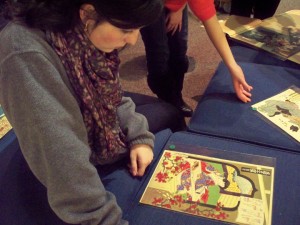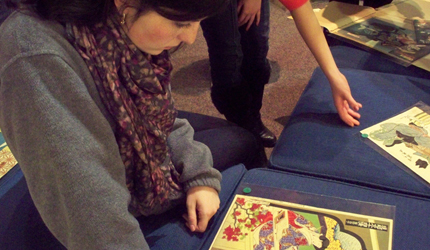
Houston sophomore and Medical Humanities major Ali Tucker studies a work of art during Mary Ruth Smith’s lecture in the class Visual Arts and Healing.
By Liz Hitchcock
Reporter
This semester Baylor has added a new course to the curriculum for Medical Humanities majors and minors. The course, Medical Humanities 3300: Visual Arts and Healing, is focused on the study of healing through art techniques that will fine tune and enhance motor skills.
“Art provides a different way of looking at problems,” said Linda Bostwick, a nurse practitioner in the Baylor health center. “In reality, and in a clinical setting, sometimes that’s a more useful way to view it, a more holistic way. Art can also be a form of stress relief.”
When most people consider an art class, or view art on a surface level, they may not necessarily realize the connection between art and medicine; however, according to the class, there are substantial benefits in coordinated and simultaneous study of the two.
Not only does the use of one’s hands in sculpture and fiber arts promote dexterity, but visual arts can train one’s eyes to recognize details that would otherwise go unnoticed.
“The reason for this class, in part, is because the world of medicine is noticing that doctors are shifting their concentrations in diagnosis away from visual assessment of a patient in favor of lab testing,” said Karen Pope, a senior lecturer in art history. “There’s a worry that something is being lost in the process.”
Dr. James Marcum, Director of medical humanities, has been looking forward to the implementation of this class and hopes students will be able to take away a new method of seeing things.
“I’ve been wanting to have a course that would emphasize the ability to be able to perceive more rigorously and with skill rather than just taking a look at a piece of work,” he said. “To really being able to observe keenly, rather than just superficially or quickly.”
Bostwick is the professor and lecturer for the course, which will also feature eight guest lecturers. The majority of the lecturers are from the art department, and each will concentrate on one aspect of therapeutic art or art that will refine the students’ senses.
The first class session was Monday, Jan. 10 when Pope began her section on observational exercises, ranging from rudimentary assignments to critical examinations.
Pope displayed Japanese wood block prints, where the artist used a different block or stamp for each color. She instructed the students to count how many blocks the artist would need to create the images they were looking at. The exercise challenged students to study the picture, notice details, and use their sense of sight at a higher level than they would normally use to view a piece of artwork.
Another guest lecturer, Mary Ruth Smith, teaches fiber arts and 2-dimensional design in the art department. Her section of the course is titled “Stitches and Staples,” referring to both a medical and artistic context.
During Smith’s week with the class, she will teach the students how to make coil baskets out of fabric in a project that they will finish outside of class for stress relief and hand-eye coordination.
“Art is therapy for me; it clears my mind, it keeps me active, and this is what I want the students to feel too,” Smith said. “I think nurses and people in the medical field need a letdown and something that they can do with their hands to make them feel more comfortable with their hands, just something that gives them an outlet.”
Sandra Gregor, an art consultant who curated the art for Dell Children’s Hospital in Austin, will be lecture on “Visual Art in the Healthcare Environment.”
Gregor will help the students come up with ideas for their service learning project. At the end of the semester, the students will visit Waco’s Family Health Center and research ways that the environment of the clinic can be changed through art to facilitate healing and benefit patients.
Other lecturers bring different concepts to the table including: patient work, viewing medical related artwork, activities such as self-portraiture and even playing the part of patient in a session of art therapy. These lecturers include: Katie Edwards, assistant professor of art history; Leah Force, lecturer in 2- and 3-dimensional design; Julia Hitchcock, professor of art; Grace Ladd, Americorps Volunteer and Deanna Miesch, art therapist.
Between the excitement of the professors and the determination of the students, Medical Humanities 3300 can become a course where both faculty and students alike can increasingly discover things about themselves and the environment around them.
“That’s what art does for us – it interprets the world and gives meaning,” Marcum said. “So hopefully students will come out of this being better observers rather than taking for granted that our most powerful and the sense that we gather the most information from: our vision.”






